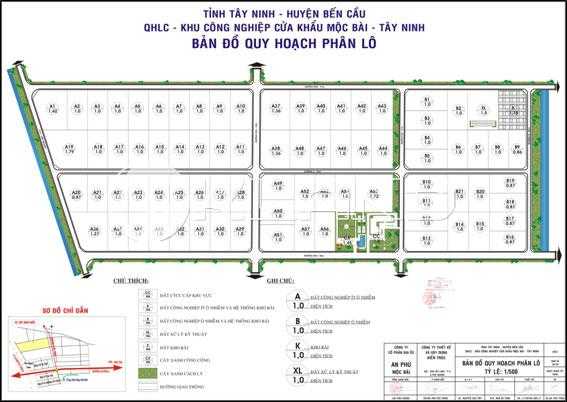An Phu Industrial Park is located on the Trans-Asia route connecting Singapore, Malaysia, Thailand, Myanmar, Laos, Cambodia, away from:
Phnompenh Capital: 170 Km.
Traffic planning
External traffic:
Road: According to the planning of the Southern Key Economic Zone, there will be a Trans-Asia expressway based on National Highway 22. This is an important traffic route connecting the Moc Bai Border Gate Industrial Park with Ho Chi Minh City and Cambodia.
Railway traffic: According to the planning of the Southern Key Economic Zone, there will be a HCMC - Phnom Penh railway line, which will be determined by the Southern Transport Consulting Company.
Internal traffic of the industrial park:
Based on the shape of the land boundary and external traffic, the road network is designed parallel and perpendicular to the surrounding roads that have been designed and built. The road network includes the following routes:
Main vertical and horizontal road system: DN3, DN2 and DD3 with a road boundary of 40m.
Internal road system: road 28 with a road boundary of 31m, roads A, B and road DN4 with a road boundary of 20m.
Rainwater drainage system planning:
The rainwater drainage system is designed with centrifugal reinforced concrete pipes with pipe diameters from Þ400 – Þ1000.
Dig channels along the perimeter of the industrial park to drain surface water and wastewater.
Rainwater is collected into manholes down the sewers arranged along both sides of the sidewalks of the roads and then flows into the canals pouring into the Dia Xu Canal.
The rainwater drainage system is divided into 6 basins and poured into 6 main pipelines to flow into the canals.
Wastewater drainage system planning:
Total wastewater flow of the industrial park: 3296m3/day with a standard of 32m3/ha-day, accounting for 80% of the water supplied to the industrial construction area, operating works and technical hubs.
Industrial park wastewater is treated in 2 stages:
First level: Local treatment at factories according to the standards set by the management board of industrial parks before discharging into the wastewater drainage system of the industrial park.
Second level: (centralized treatment) first-level treated wastewater is brought to the centralized treatment station of the whole area to meet Vietnamese standards (TCVN-5945-95) before being discharged into the canal system.
Water supply system planning:
According to the general plan for water supply to the Moc Bai border gate urban trade area for the industrial park, there will be 2 water supply points: one point at the intersection of Provincial Road 786 with a pipe diameter of D200 and one point at the intersection with National Highway 22 with a diameter of D300, these 2 routes are connected to each other into a pipe with a diameter of D250 running on the main road parallel to National Highway 22 to supply the industrial park.
Water plant: (water treatment area) construction capacity of 4300m3/day. The construction land area is 40mx40m.
The water pipe from the water plant has a diameter of Þ 300, then Þ200, Þ150 pipes run through all the roads in a ring, arranging pipes on both sides of the road for convenient connection with factories as well as fire prevention and fighting.
Electricity supply system planning:
The electricity supply for the Moc Bai border gate industrial park is expected to be taken from the 110/22KV station of the Moc Bai border gate urban trade area. In the immediate future, electricity is received from the medium and low voltage lines along National Highway 22 and Provincial Road 786 (about 500 m from the land).
From the 110/22KV station, 3 phases of 22 KV will be pulled, each line carrying about 10 MVA to supply electricity to the industrial park. The 22 KV lines in the industrial park will be built along the traffic routes to lead to the factories. These lines will be built in a ring (open operation with load switching devices to ensure safe power supply).
Telecommunications system planning:
The telecommunications system for the Moc Bai - Tay Ninh border gate industrial park will be a system connected to the telecommunications network of Tay Ninh Post Office (specifically from the Bien Cau Post Office center), the exchange of the area is designed to have a capacity of about 1000 machines



